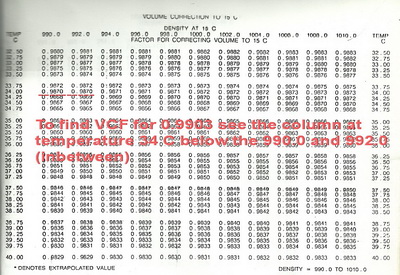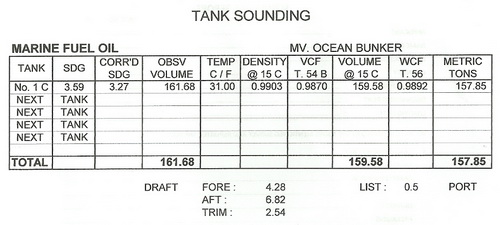What is Bunker Survey? The survey is carried out to measure and ascertain the quantity of Bunker onboard at the specific time. This survey is produced the report that states the amount of bunker, usually Fuel Oil (FO) and Diesel Oil (DO), and sometimes Lubricating Oil (LO) is included.
In this post limits to how to conduct the Bunker Survey on the ship tanks only.Commonly this is done prior to and after a time charter period than mentions as On Hire Bunker (prior) and Off Hire Bunker (after), the Bunker Survey is required to check the amount Bunker transferred or supplied onto the Ship’s Tanks. This job is associated with Ship’s Chief Engineer, the Person who responsible for bunker onboard.
Survey Tools required for Bunker Surveyor
- Notes Book,
- Sounding Tape,
- Thermometer,
- Density Meter for Oil (0.750 -1.000),
- Oil and Water Paste,
- Petroleum ASTM Table 54B (for Product Oil) and Table 56,
- Google and Glove,
- Flashlight,
- Sampling Can,
- Bottle or Can for Sampling (if required taken samples).
Steps for Conducting Bunker Survey
- Identify and records the number and Depth of Tank, Reference Height, and Measuring Method recommended to use (Ullage or Sounding) for each Oil Tank. Sounding is determined the level of liquid tank from the bottom of the tank to the liquid surface (typically applied for light liquid). Ullage means to determine the level of liquid of tank by measured the empty space from top of the Tank (the mouth of Sounding Pipe) to the liquid surface (typically applied for heavy liquid). The both methods will point to the same result.
- Record the Last Bunker Report, Time and Place of last Bunker supplied, includes the Oil density.
- Records the quantity of bunker onboard when the ship arrives at Port (arrival Condition) as per Engine Log Book.
- Checking the accuracy of the Sounding Tape, it is recommended to use your own Sounding Tape. In case we used Ship’s Sounding Tape, please checking the tape.
- Sounding each Oil Tank and records the level of Oil on the tank. Attached the sounding Tape with Oil Paste to make easy and clear to show of oil level (recommended for Light Oil).
- Check the Ship’s Draft Marks to get the Ship Trim for Trim correction, and check the ship Inclination or Listing for List Correction, that is required to calculate the Tank Quantity Table.
- Taken Oil sample, check temperature and oil density, for the accessible tank only. The Service and Settling Tanks are not accessible due to the oil on that tanks were in heating condition at the high temperature. We could records the tank gauging for determining the quantity, the temperature at the thermometer available on each tank, and the Oil Density from the Engine Log Book. If you could not taken the oil sample for checking density, it is recommended to calculate the Density Commingle, by means the Combine Density between two Oils (Old and New Oils) that has mixed on one tanks which they have different in Density. Where it is approaching the actual oil density, the pattern is {(Old Oil Quantity x Oil Density / Total Oil on Tank) + (New Oil Quantity x Oil Density / Total Oil on Tank)}.
- Calculations, this stage will involved the Sounding level of each tank, Ship’s Trim and List, Tank Quantity Table (provided by Ship’s Chief Engineer), Oil Density and Temperature, ASTM Table 54B to ascertain the Volume Correction Factor (VCF – to convert from Cubic Meter to Kiloliter) and ASTM Table 54B for Weight Correction Factor (WCF – to convert from Kiloliter to Metric Ton).
- Example to calculate Density Commingle: FO Tank No. 1 C, total oil on tank 400 Cu.M, Old Oil 200 Cu.M with density 0.9870, and New Oil 200 Cu.M with density 0.9720. Density Commingle = {(200 x 0.9870 / 400) + (200 x 0.9720 / 400)} = 0.4935 + 0.4860 = 0.9795.
- Issued the Tank Sounding and Bunker Report.
I think now you could conduct Bunker Survey, the Detail of Bunker Survey Calculation will be post shortly. Let me know if I miss something by your comments and feedbacks.
The bunker calculation is simple and needs the following:
- Tank Sounding data and Tank Capacity Table. The Corrected Sounding means below is the sounding after correcting with vessel’s trim and list.
- Temperature of Oil on Tanks,
- Oil Density @15C,
- Table ASTM 54B (VCF) and Table ASTM 56 (WCF).
Now we could go with sample of 1 tank to test the calculation.
** Question :
FO Tank No. 1 Center, Corrected Sounding = 3.27 Meter, Temperature = 34 degrees celcius, Density @ 15 C = 0.9870.
Tank Volume at Sounding 3.20 M = 157.20 Cubic Meter, at Sounding 3.30 M = 163.60 Cubic Meter.
** Answer :
- The Quantity in Metric Ton = Oil Vol x VCF x WCF,
- Observe Volume = {(3.27 – 3.20) / (3.30 – 3.20) x (163.60 – 157.20)} + 157.20 = (0.07/0.10) x (6.40) + 157.20 = 4.48 + 157.20 = 161.68 Cu.M.
- T 54B (VCF) > Density @ 15C 0.9903 at 34 C = 0.9870 (see the picture below you need to interpolate if any different numbers on both columns).
- T 56 (WCF) : Density @15C 0.9903 at 34 C = 0.9892 (Quick formula with reducing factor for WCF is Density @ 15C – 0.0011 = 0.9903 – 0.0011 = 0.9892). We don’t need to see the table anymore.
- So, The Quantity in MT is 161.68 x 0.9870 x 0.9892 = 157.85 MT. Sample calculation tanks sounding attached below.
Note : If you do calculation with Volume in Barrel, just uses ASTM Table 6B for VCF, ASTM Table 11 for WCF in Long Ton and then ASTM Table 13 for WCF in Metric Ton.








0 Response to "How to Conduct Bunker Survey"
Posting Komentar